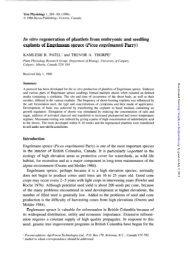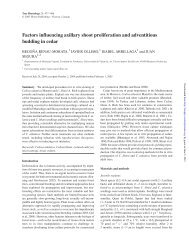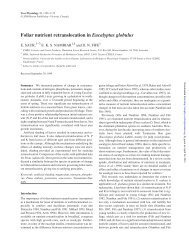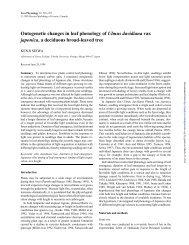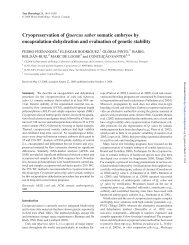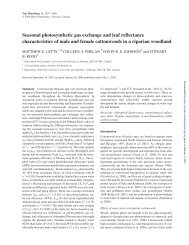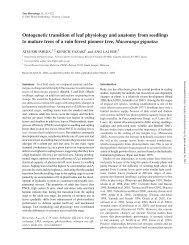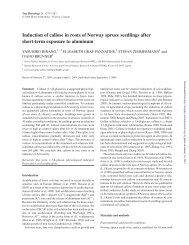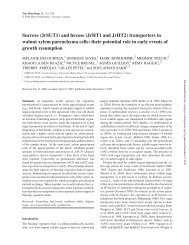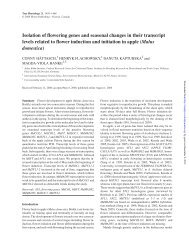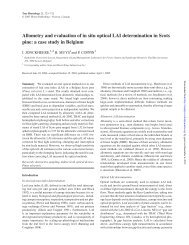Hara: the effect of xylem structures - Tree Physiology
Hara: the effect of xylem structures - Tree Physiology
Hara: the effect of xylem structures - Tree Physiology
Create successful ePaper yourself
Turn your PDF publications into a flip-book with our unique Google optimized e-Paper software.
sels seemed to be embolized by dehydration (Figures 5B vs.<br />
A). After rewatering, embolized vessels in some size classes <strong>of</strong><br />
current <strong>xylem</strong> were refilled 1 h after rewatering (Figure 5C).<br />
The refilling was clearer in smaller vessels for 12-h rehydration<br />
(Figure 5D). In 1-year-old <strong>xylem</strong>, most vessels had already<br />
embolized in <strong>the</strong> absence <strong>of</strong> water stress (Figure 5E), as reported<br />
previously (Sperry and Sullivan 1992, Cochard<br />
2006), and remained embolized, irrespective <strong>of</strong> rewatering<br />
(Figures 5F–H).<br />
In B. platyphylla, although all sizes <strong>of</strong> vessel were functional<br />
before dehydration in current and 1-year-old <strong>xylem</strong><br />
(Figures 6A and E), 50% or more <strong>of</strong> vessels in each size class<br />
were embolized when water stress was induced (Figures 6B<br />
and F). Larger vessels were embolized by dehydration, espe-<br />
LOSS OF XYLEM CONDUCTIVITY AND ITS RECOVERY 7<br />
Figure 6. Percentage <strong>of</strong> functional and embolized vessels in each 5-µm class in B. platyphylla. Gray and open bars, respectively, represent<br />
functional and embolized vessels: A–D show data for current <strong>xylem</strong>; E–H are for 1-year-old <strong>xylem</strong>; A and E, before dehydration; B and F, after<br />
dehydration; C and G, 1 h after rewatering; D and H, 12 h after rewatering. Class mean ± 95% <strong>of</strong> <strong>the</strong> confidence interval (n = 3).<br />
cially in 1-year-old <strong>xylem</strong>. The rapid refilling <strong>of</strong> <strong>xylem</strong> vessels<br />
was observed during 1-h rehydration (Figures 6C and G).<br />
At 12 h after rewatering, most vessels in all classes had fully<br />
refilled in <strong>the</strong> current <strong>xylem</strong> (Figure 6D), although about 20%<br />
<strong>of</strong> vessels were still embolized in 1-year-old <strong>xylem</strong><br />
(Figure 6H). At 1 h after rewatering, larger vessels <strong>of</strong> current<br />
<strong>xylem</strong> appeared to be embolized still; <strong>the</strong>y were cases in<br />
which vessels <strong>of</strong> more than 50 µm diameter belonged to only<br />
one plant.<br />
Composition <strong>of</strong> Ks in B. platyphylla<br />
Theoretical specific hydraulic conductivity (K s) in current<br />
and 1-year-old <strong>xylem</strong> <strong>of</strong> B. platyphylla is portrayed in Fig-<br />
TREE PHYSIOLOGY ONLINE at http://www.treephys.oxfordjournals.org<br />
Downloaded from<br />
http://treephys.oxfordjournals.org/<br />
by guest on December 10, 2012



